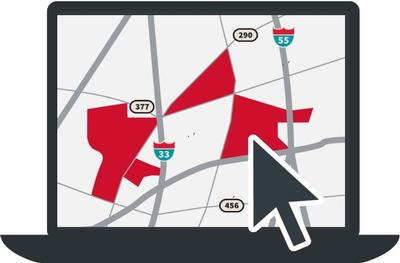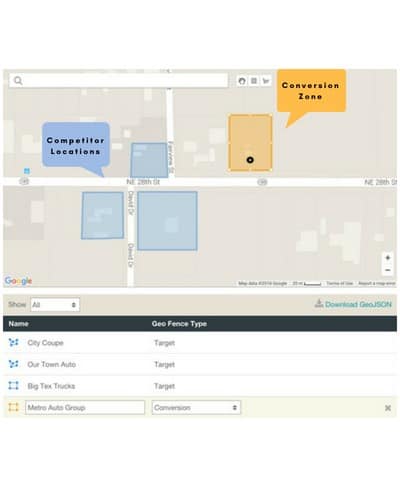What is Geofencing
Geofencing (or geo-fencing) is the practice of using GPS (Global Position) or RFID (Radio Frequency Identification) to define highly specific geographic boundaries or enclosures of interest. Put more simply, a geofence is simply a virtual perimeter around a real geographical area. This area could be as large as an entire city, or as small as a location within a building. For the purposes of marketing, and depending on how a geofence is configured, it can trigger targeted advertisements or push notifications when a mobile device enters or exits this virtual boundary. This allows an advertiser to connect with consumers in real-time who are visiting specific and/or relevant locations to your products or services.

Geofencing Applications
Geofencing provides an avenue to connect with consumers directly on their phones when they visit locations and events like hospitals, concerts, malls, sporting events, car dealerships, real estate offices or conventions. Ads can be displayed either in real-time or a period of time after they have entered a geofenced area. These ads are displayed on a network of mobile apps (popular news, weather and gaming apps for example) or while they are browsing the internet from their mobile device. Creating customer engagement based on someone’s exact location and apparent interest can lead to meaningful and timely advertisements and communications. The following are just a few application examples for geofencing:
Real Estate: A home builder could use geofencing to drive awareness and purchases among potential home buyers by targeting competitor sales offices and/or real estate offices. People visiting these locations qualify as geofencing targets as they show intent for a new home purchase.
Legal: A law firm could target places such as hospitals, urgent care centers, car repair shops, towing centers, etc… In the hospital scenario, engagement with the “medical system” is the best indicator of need.
Retail: A local retailer could target competitor brick and mortar locations or send promotional messages as shoppers pass by its own store. When users pass through, a location-triggered deal could make them more likely to stop-in and shop.
Online Store: An online retailer could set-up a geofence around an industry expo. This store could then provide personalized offers on related products. If this retailer also had its own brick and mortar locations, it could target those locations as well, thus bridging the gap between ecommerce and in-store purchases by moving customers more seamlessly between the two.
Automotive: In the example below, a car dealership has geofenced 3 competitors whereby ads will be served when a person enters or leaves a competitor location after browsing for a vehicle. This car dealership has established its location as a “conversion zone,” whereby conversions are recorded when a person who is served an ad enters their location.
Is Geofencing Right for your Business?
Geofencing can be an effective tool for companies with brick-and-mortar locations or companies that have strong connections to brick-and-mortar locations, but the application uses are becoming increasingly varied and nuanced. However, Geofencing may not be the right fit for every company’s mobile marketing strategy. The below are a few considerations to guide your decision:
- Do you have an established mobile presence, or do you need to improve your mobile presence?
- Are your customers or potential customers mobile-centric?
- What kind of messaging is appropriate for your target demographic?
- Will geofencing will be useful to your potential customers, or is it just another way to sell to your audience?
- How would this channel work with and/or enhance other channels and campaigns?
- There are requisite security and privacy policy considerations inherent to such a program and app.

Next Steps
The explosive growth of mobile use has transformed the way consumers shop and research services and products. According to Google, over 40% of shoppers like to complete their entire shopping journey (from research to purchase) on a mobile device. Geofencing is a remarkably useful tool to enhance your mobile presence by targeting potential customers at the right time, with the right message, and with superior consumer targeting practices.
If you have any questions about geofencing, such as whether it’s a good fit for your business, please do not hesitate to contact us.
